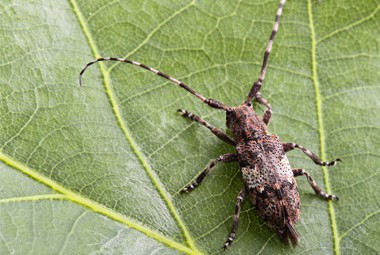
Longhorned beetles receive their name from their extremely long antennae. They are a species of wood destroying insect that are found living throughout the United States.
| Pest Identification | |
|---|---|
| Recognition | Adult longhorned beetles grow to be about 3/8th to 1 inch in length. They have an elongated body that is cylindrical in shape. Their distinctive antenna is longer than the length of the body. Larvae can grow to be slightly bigger than the adult- 3/8th to 1 ½ inches in length. They have a cylindrical worm-like body that has a rounded thorax. Depending on the species, they can be legless or have very short “spiny” legs. The larvae are whitish or cream in color. |
| Biology | The life cycle of the female longhorned beetle begins in the spring, summer, or fall when they lay their eggs in the cracks of wood or bark. Larvae hatch from the eggs after a few days and will enter the wood and begin feeding on it. As the larvae grow and develop, they will bore deeper into the wood. The amount of time the larval stage lasts greatly depends on the nutritional value of the wood and/or its moisture content. When it is time to pupate the larvae will move back up to the surface of the wood. After emerging from the wood as an adult, they will mate, lay their eggs, and die. The entire life cycle of the long-horned beetle can take 2-3 years to complete; most species do not re-infest seasoned wood and are therefore considered to be nuisance pests. |
| Habits | When found outdoors longhorned beetles are a beneficial species; they are responsible for decomposing dead or injured trees- returning nutrients back into the soil. Long-horned beetles typically attack unseasoned wood, logs, and lumber. These pests often enter homes through wood that is already infested with the larvae or when the adults find their way in through open windows, doors, cracks, and crevices. A common sign that longhorned beetles have been introduced into your home is finding oval exit holes that are 1/8th to 3/8th of an inch in diameter in wood or lumber located within your home. You may also notice fine wood shavings located underneath the exit holes. Because most species do not re-infest wood, their damage is mostly cosmetic and not structural. |
| Prevention | Preventing problems with these pests can be difficult because they can remain dormant for years before emerging from wood and becoming a problem. The best way to stop problems with these pests is to have a year-round pest control service in place to catch an infestation sooner than later, and begin treatment as quickly as possible. |
| Professional | The most effective way to control longhorned beetles around your property and in your home or business is through the help of a professional pest control expert. At Rottler Lawn & Pest Solutions a trained technician will inspect your home and find the infested areas. If treatment is needed, our technician will suggest a plan for treatment that may include either borates or in some cases fumigation may be utilized. Treatment may also include applying boron-containing insecticides to reduce the chances of a re-infestation and wood decay before the logs are sealed. If signs of longhorned beetles are noticed in your Missouri home, call the pest control experts at Rottler today! |

